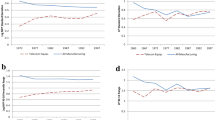Abstract
This paper discusses the stylized facts, the theory, and the remaining problems of productivity dispersion, which is essentially related to the concept of equilibrium in the neoclassical theory. Empirical study of data relating to Japanese firms shows that they all obey the Pareto law, and also that the Pareto index decreases with the level of aggregation. In order to explain these two stylized facts we propose a theoretical framework built on the basic principle of statistical physics and on the concept of superstatistics, an approach that accommodates fluctuations of aggregate demand. We show that the allocation of production factors depends crucially on the level of aggregate demand, and that the higher the level of aggregate demand, the closer the economy is to the frontier of the production possibility set.
Similar content being viewed by others
References
Aoki M, Yoshikawa H (2007) Reconstructing macroeconomics—a perspective from statistical physics and combinatorial stochastic processes. Cambridge University Press, Cambridge
Aoyama H, Yoshikawa H, Iyetomi H, Fujiwara Y (2009) Labour productivity superstatistics. Prog Theor Phys Suppl 179: 80–92
Aoyama H, Fujiwara Y, Ikeda Y, Iyetomi H, Souma W (2010) Econophysics and companies—statistical life and death in complex network. Cambridge University Press, Cambridge
Arrow K, Block H, Hurwicz L (1959) On the stability of the competitive equilibrium, II. Econometrica 27: 82–109
Beck C (2006) Superstatistical Brownian motion. Prog Theor Phys Suppl 162: 29–36
Beck C, Cohen EGD (2003) Superstatistics. Physica A 322: 267
Canning D, Amaral L, Lee Y, Meyer M, Stanley H (1998) Scaling the volatility of GDP growth rates. Econ Lett 60(3): 335–341
Champernowne D (1973) The distribution of income between persons. Cambridge University Press, Cambridge
Davis S, Haltiwanger J, Schuh S (1996) Job creation and destruction. MIT Press, Cambridge, MA
Delli Gatti D, Gaffeo E, Gallegati M, Giulioni G, Palestrini A (2008) Emergent macroeconomics. Springer, Berlin
Fay JA, Medoff JL (1985) Labor and output over the business cycle: some direct evidence. Am Econ Rev 75: 63–655
Foley D (1994) A statistical equilibrium theory of markets. J Econ Theory 62(2): 321–345
Gabaix Z (2005) The granular origins of aggregate fluctuations. MIT and NBER, DP
Ijiri Y, Simon HA (1975) Some distributions associated with Bose–Einstein statistics. Proc Natl Acad Sci USA 72(5): 1654–1657
Ijiri Y, Simon HA (1977) Skew distributions and the sizes of business firms. North-Holland Pub., Co., Amsterdam
Ikeda Y, Souma W (2009) International comparison of labor productivity distribution for manufacturing and non-manufacturing firms. Prog Theor Phys Suppl 179: 93–102
Keynes J (1936) The general theory of employment, interest, and money. Macmillan, London
Kydland F, Prescott E (1982) Time to build and aggregate fluctuations. Econometrica 50: 1345–1370
Lucas R Jr (1972) Expectations and the neutrality of money. J Econ Theory 4: 103–124
Lucas R Jr (1987) Models of business cycles. Basil Blackwell, New York
Marsili M, Zhang YC (1998) Interacting individuals leading to Zipf’s law. Phys Rev Lett 80(12): 2741–2744
Mortensen DT (2003) Wage dispersion. MIT Press, Cambridge
Nikkei Media Marketing, Inc. (2008) Nikkei NEEDS CD-ROM. http://www.nikkeimm.co.jp/english/index.html
Okun AM (1962) Potential GNP: its measurement and significance. In: Proceedings of the business and economic statistics section, American Statistical Association, pp 98–104
Okun AM (1973) Upward mobility in a high-pressure economy. Brookings Pap Econ Act 1: 207–261
Phelps E (1970) Microeconomic foundations of employment and inflation theory. Norton, New York
Saichev A, Malevergne Y, Sornette D (2009) Theory of Zipf’s Law and Beyond. Springer, Berlin
Solow RM (2000) Growth theory: an exposition. 2nd ed. Oxford University Press, New York
Stanley H, Gopikrishnan P, Plerou V (2004) Statistical physics and economic fluctuations. The complex dynamics of economic interaction: essays in economics and econophysics, p 109
Sutton J (1997) Gibrat’s legacy. J Econ Lit 35: 40–59
Tobin J (1972) Inflation and unemployment. Am Econ Rev 62: 1–18
Touchette H, Beck C (2005) Asymptotics of superstatistics. Phys Rev E 71(1): 16131
Yoshikawa H (2003) The role of demand in macroeconomics. Jpn Econ Rev 54: 1–27
Author information
Authors and Affiliations
Corresponding author
Additional information
The authors would like to thank Dr. Y. Ikeda and Dr. W. Souma for various discussions related to the topics discussed in this paper. We also wish to acknowledge the generous support of the Hitachi Research Institute and Hitachi Ltd for a grant towards part of our research, and the Research Institute of Economy, Trade and Industry for supporting Hiroshi Yoshikawa’s work. We are grateful to the Yukawa Institute for Theoretical Physics (YITP) at Kyoto University for allowing us to use their computing facility, and to the participants at the YITP workshop YITP-W-07-16 “Econophysics III Physical approach to social and economic phenomena” for helpful comments while we were completing our investigation.
Rights and permissions
About this article
Cite this article
Aoyama, H., Yoshikawa, H., Iyetomi, H. et al. Productivity dispersion: facts, theory, and implications. J Econ Interact Coord 5, 27–54 (2010). https://doi.org/10.1007/s11403-010-0063-9
Received:
Accepted:
Published:
Issue Date:
DOI: https://doi.org/10.1007/s11403-010-0063-9




